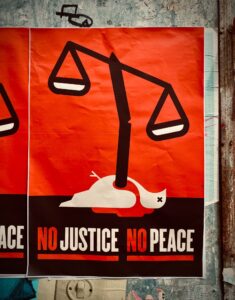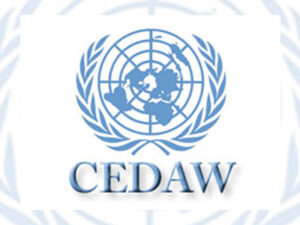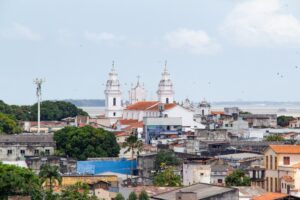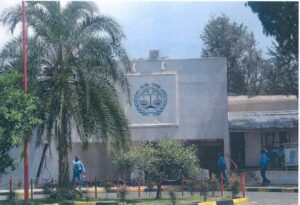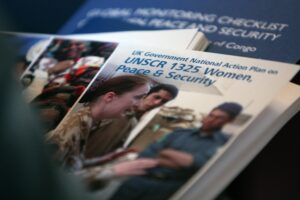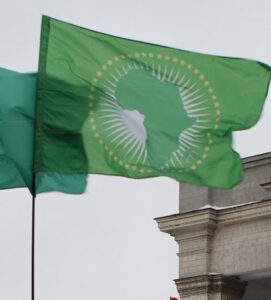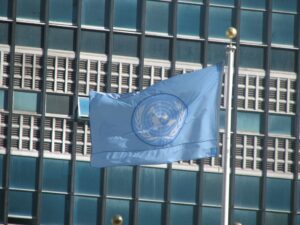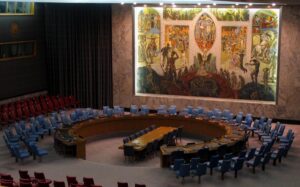Creating Story Maps and Timelines with free Knight Lab tools
Getting dirt under our fingernails: Your turn!
Getting dirt under our fingernails: Your turn!
Now that you have learned the basics on how to use the Knight Lab tools, StoryMapJS and TimelineJS, it is time to put those new skills into practice. For the remainder of this workshop, and with the guidance of CSiW graduate assistants and digital librarians, you will create your own StoryMap or Timeline using the material provided.
For the following exercise, the CSiW Scalar Team has compiled a series of international legislation, resolutions, and platforms created to target gender and sexual violence. We have also provided a brief description and images for you to use throughout the exercise. If you would prefer to search for your own images to feature on your Timeline or StoryMap, please use Wikimedia Commons. As you create your own StoryMap or Timeline, you will select up to 5 of the entries below to narrate the journey as gender and sexual violence in conflict has been addressed in the past decades.
Preamble: Historical Context:
“[…] the global feminist movement is deeply rooted in women’s movements around the world, not solely in Western nations […]”
Margaret Snyder, “Unlikely Godmother: The UN and the Global Women’s Movement,” in eds Myra Marx Ferree and Aili Mari Tripp Global Feminism: Transnational Women’s Activism, Organizing, and Human Rights (New York: New York University Press, 2001), 24.
In the above text, Snyder develops a history of what she terms grassroots women’s movements and global feminist movements’ “search for justice.” Snyder attends to the differences and tensions among women of the north and south, east and west, and rural and urban spaces. In Snyder’s history, it is clear that women have been agents of change who have laid the groundwork for and directed legislation addressing their needs. As Snyder writes, “The creation of the United Nations opened opportunities for women to promote justice for themselves and their societies, and women seized them” (25). The following events, drawn from Snyder’s chapter, were foundational to the development of the legislation this exercise engages:
-
Four of 160, 1945: In San Francisco, four women, Bertha Lutz representing Brazil, Way Sing New representing China, Minerva Bernardino representing the Dominican Republic, and Virginia Gildersleeve representing the United States, were among the 160 delegates who signed the United Nations Charter. These four women demanded that its preamble speak explicitly of “equal rights.”
-
Commission on Human Rights, 1946: the Economic and Social Council included a subcommission on the status of women. This was not enough and organizers agitated for a commission of their own.
-
United Nations Children’s Fund, 1946: this fund was established to help child victims of World War II and it provided maternal and child health services to women. However, women argued that the fund did not address all of their needs for economic, social, and political change, nor did it recognize them as central agents of economic productivity.
-
The Commision on the Status of Women (CSW), 1947: the CSW was to promote women’s rights and equality by setting standards and formulating international conventions that would change national discriminatory legislation and foster global awareness of women’s issues. However, as Snyder notes, “Western women […], rich with communications technologies, […] often overlay on developing countries inappropriate gender stereotypes of their own societies” (26). That western-centric, and often white-centric, way of relating has always been contested and challenged. A shift occurred when fifty-four former colonies that had won independence from colonial forces joined the UN in the 1950s and 1960s. With the growth of UN membership, CSW went from six members in 1960 to nineteen in 1969.
-
United Nations Economic Commission for Africa (UNECA), 1958: A focus on economic development followed winning independence from colonial forces. The UNECA was the first UN organization to fully recognize and act on women’s central roles in community and economic development. The UNECA implemented resolutions women made at their Africa-wide seminars.
-
“The integration of women in development,” 1969: Gloria Scott of Jamaica, a UN staff person, suggested the inclusion of “the integration of women in development” in the UN’s international development strategy. Scott’s intervention occurred as the UN’s development model emphasizing “trickle down” economics and “modernization” was increasingly challenged; the model did not meet the needs of all people, especially women and children. Women surviving in “post colonial” contexts articulated their understanding of development as flowing from social and economic justice.
-
World Conference of the International Women’s Year, Mexico City, 1975: Consensus was developed around the need for an international convention on women, signed by all governments. The UN Development Fund for Women (UNIFEM), which was set up to finance women’s activities in low-income countries, and the International Research and Training Institute for the Advancement of Women (INSTRAW), which was to engage in research and training, as well as the Convention on the the Elimination of Discrimination Against Women (CEDAW), followed.
Regarding CEDAW, which, in this exercise, is the first in our series of international legislation, resolutions, and platforms created to target gender and sexual violence, Snyder writes:
“Following the advice of the Mexico City conference, women’s long term goals to transform oppressive laws and distribute national wealth more equitably were advanced with the acceptance in 1979 of the first human rights treaty for women, the UN’s Convention on the Elimination of All Forms of Discrimination against Women” (34).
Make your own TimelineJS and / or StoryMapJS telling the story of international legislation, resolutions, and platforms targeting gender and sexual violence.
The first entry, titled “1. Potential Cover Title: International Legislation Targeting Gender & Sexual Violence” can be drawn from in creating your Home Page.
Entries 2-11 can be drawn from to show locations & events for your Knight Lab TimelineJS & StoryMapJS.
1. Potential Cover Title: International Legislation Targeting Gender & Sexual Violence
Wikimedia Entry: https://commons.wikimedia.org/wiki/File:No_Justice_No_Peace_Poster_by_A._Lecuna.jpg
Image:
2. Convention on the the Elimination of Discrimination Against Women (CEDAW)
Date: Adopted 18 December 1979, entered into force 3 September 1981
Location: New York City, New York
About: This international convention was the culmination of over thirty years of work by the UN Commission on the Status of Women, established in 1946, to promote and monitor women;s rights. The Convention has been fundamental in creating an agenda for action by countries to guarantee women’s enjoyment of their rights. In its approach, the Convention covers three dimensions of the situation of women: civil rights and the legal status of women, women’s reproductive rights, and the impact of cultural factors on gender relations.
Wikimedia entry: https://commons.wikimedia.org/wiki/File:Cedaw.jpg
Image:
3. Declaration on the Elimination of Violence against Women (DEVAW)
Date: Issued 20 December 1993
Location: New York City, New York
About: DEVAW was adopted by the UN General Assembly in the 48/104 Resolution in 1993. Adopted without a vote, this declaration was the first international instrument to explicitly address VAW, while providing a framework for national and international action. Although, as a UNGA declaration, DEVAW does not have the binding authority of a treaty or convention, it is universal in coverage and a strong statement of principle to the international community, in its commitment to fight violence against women.
Wikimedia entry: https://commons.wikimedia.org/wiki/File:United_Nations_Plaza_buildings_-_New_York.jpg
Image:
4. Inter-American Convention on the Prevention, Punishment and Eradication of Violence against Women (Belém do Pará Convention)
Date: Adopted 9 June 1994, entered into force 5 March 1995
Location: Belém do Pará, Brazil
About: This convention was adopted by the Inter-American Commission of Women of the Organization of American States (OAS), and it is the first international piece of legislation that criminalizes all forms of violence against women, especially sexual violence. In its definition of violence against women, this declaration deems VAW as human rights violation, consisting of physical, sexual and/or psychological violence.
Wikimedia entry: https://commons.wikimedia.org/wiki/File:S%C3%A9_de_Bel%C3%A9m_vista_do_Farol_(1).jpg
Image:
5. The Beijing Declaration or Beijing Platform for Action, Fourth World Conference on Women
Date: Adopted 15 September 1995
Location: Beijing, China
About: The Beijing Declaration was the resolution adopted at the end of the Fourth World Conference on Women. Platform for Action follows the Beijing Declaration, and is considered the most progressive blueprint for advancing women’s rights. Among the areas of concern, violence against women and women and armed conflict are considered as areas where urgent action is needed to bring about change.
Wikimedia Entry: https://commons.wikimedia.org/wiki/File:Hillary_Rodham_Clinton_Addresses_the_Fourth_United_Nations_Conference_on_Women_at_the_Beijing_International_Conference_Center_in_Bejiing,_China_-_NARA_-_131493880.jpg
Image:
6. The prosecutor v. Jean-Paul Akayesu, International Criminal Tribunal for Rwanda Case ICTR-96-4-A
Date: Decision was made 1 June 2001
Location: Arusha, Tanzania
About: The Akayesu case marks the first time that an international tribunal recognized rape and sexual violence as a means of perpetrating genocide, and as a crime against humanity. This case marked an important step towards ending impunity for acts of sexual violence during armed conflict.
Wikimedia Entry: https://commons.wikimedia.org/wiki/File:Ictr_office_3.jpg
Image:
7. United Nations Security Council Resolution 1325 (S/RES/1325)
Date: Adopted in 2000
Location: New York City, New York
About: Calls for the inclusion of women and gender concerns in conflict resolution and peace-making initiatives. This resolution was a milestone in addressing violence against women in situations of armed conflict. Recognizing the need to fully implement laws that protect the rights of women and girls during and after armed conflict, it calls for special measures to protect women and girls from gender-based violence in armed conflict. It also emphasizes the responsibility of all States to put an end to the impunity of perpetrators.
Wikimedia entry: https://commons.wikimedia.org/wiki/File:UNSCR_1325_Women,_Peace_%26_Security_(5206218045).jpg
Image:
8. The Protocol to the African Charter on Human and People’s Rights on the Rights of Women in Africa (The Maputo Protocol)
Date: Adopted July 2003
Location: Maputo, Mozambique
About: This women’s rights treaty includes a strong definition of violence against women and covers “both actual violence and acts that could lead to violence.” Driven by African women’s rights NGOs, it was created in response to a lack of implementation of the African Charter. Additionally, this is the first binding convention relating to women’s rights for Africa, and is the first internationally to define ‘unwanted or forced sex’ as a form of violence against women.
Wikimedia entry: https://commons.wikimedia.org/wiki/File:African_Union_Flag.jpg
Image:
9. United Nations Security Council Resolution 1820 (S/RES/1820)
Date: Adopted 19 June 2008
Location: New York City, New York
About: This resolution recognizes sexual violence as a tactic of war, calls for training of troops for responding and preventing sexual violence, and recognizes that rape and other forms of sexual violence can constitute a war crime, crime against humanity or constitutive act with respect to genocide.
Wikimedia entry: https://commons.wikimedia.org/wiki/File:The_Flag_of_the_United_Nations_(5013025102).jpg
Image:
10. Convention on Preventing and Combatting Violence Against Women and Domestic Violence (Istanbul Convention)
Date: Adopted 11 May 2011, entered into force 1 August 2014
Location: Istanbul, Turkey
About: This human rights treaty of the Council of Europe aims at the prevention of violence, victim protection and to end impunity of perpetrators of violence against women. This convention also includes crimes against honour. The Convention is structured based on “four Ps”: Prevention, Protection and support of victims, Prosecution of offenders, and Integrated Policies. It also establishes obligations related to the collection of data to support research in the field of VAW.
Wikimedia Entry: https://commons.wikimedia.org/wiki/File:Panoramic_view_of_Istanbul-_Yeni_Cami_(The_New_Mosque),_Galata_Bridge._Turkey,_Southeastern_Europe.jpg
Image:
11. United Nations Security Council Resolution 2467 (S/RES/2467)
Date: Adopted 23 April 2019
About: Prioritizes a survivor-centered approach to the prevention of and response to sexual violence in conflict. This resolution positions conflict-related sexual violence as rooted in the broader women, peace and security agenda, and calls for the attention to the issue of children born of rape.
Wikimedia entry: https://commons.wikimedia.org/wiki/File:UN_security_council_2005.jpg
Image:

